With little advertising, our last eight
Threads in the Sand' tours sold out quickly. We enjoy taking this tour and
because of the level of interest will take another excursion through the
lands of silk in 2013. This page gives the
flavour of our Silk Road experience. Our
2012 tour is closed.
Our next Silk Road tour is in 2013.
If you want to put your name
down for this tour or enquire further please email
your request.
You may wonder about the need to reserve a tour, years in advance. Well...we
run only a few tours each year. They are specialised, personally conducted
and, indeed - very different. If you want to know how special, please ask
and we shall provide you with contacts who have taken this tour. It is indeed
- special and 2013 will come around sooner than expected!
 n
1997 I chanced upon an exhibition at
the Museum of Fine Arts in Boston. It remains the most visually stunning exhibition
I have seen.
n
1997 I chanced upon an exhibition at
the Museum of Fine Arts in Boston. It remains the most visually stunning exhibition
I have seen.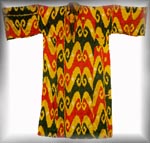 I was entranced by the vibrant colours and bold designs of ikat silk
from Central Asia and intrigued by the possibility that these gorgeous textiles
might still be produced in ancient lands of the Silk Road.
I was entranced by the vibrant colours and bold designs of ikat silk
from Central Asia and intrigued by the possibility that these gorgeous textiles
might still be produced in ancient lands of the Silk Road.
[Note: Ikat is a technique
of creating a woven patterned-cloth by tie-dying the warp (long) threads.
Successive tie-dying allows the introduction of several colours. It is intricate
and demanding work which, in the hands of gifted craftsmen, creates textiles
of striking design and subtle colouration. In Central Asia it is known as abyr or adras.]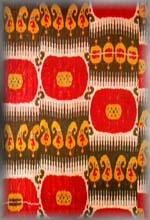
I was fascinated by the bold use of these textiles
for personal clothing. It was apparent that individuals, both men and women,
would compete in wearing the most stunning designs and at times would wear
several charpans (silk coats) at once! Inside their homes large ikat-silk
and embroidered panels were hung as decoration.
On a quest to see more of this,
Diane and I visited Kyrgyzstan and Uzbekistan. We discovered surviving remnants
of the craft and journeyed to the origins of the silk industry in China. This
tour is a compilation of what we found then and during several subsequent
visits. It is a response our initial, and persisting, enthusiasm and a celebration
of the marvellous history and crafts of China and Central Asia. It is a chance
for you to share in the history and glories of the Silk Road.
'You can extract the essence
of a place once you know how.
If you just get as still as a needle you'll be there...'
Spirit of Place: Lawrence Durrell


The
General Plan
 he
idea is to start our tourist activity in China at Xian, the ancient capital
of successive Chinese empires and to journey west from there along the route
established more than two thousand years ago: 'the Silk Road'. Our 'furthest-west'
point will be Khiva, once a major stageing post. We fly into Xian via Bangkok
and return to Bangkok from Tashkent in Uzbekistan.
he
idea is to start our tourist activity in China at Xian, the ancient capital
of successive Chinese empires and to journey west from there along the route
established more than two thousand years ago: 'the Silk Road'. Our 'furthest-west'
point will be Khiva, once a major stageing post. We fly into Xian via Bangkok
and return to Bangkok from Tashkent in Uzbekistan.
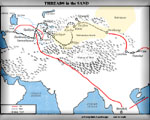 From
Xian in the east to Khiva in the most western deserts of Uzbekistan it takes
us more than six weeks to journey thousands of kilometres. A distance that
would have taken years in former times. We have researched and travelled this
region thoroughly so that all the major sites, and many often overlooked minor
ones, are included in our wanderings. When travelling, we either have our
own air-conditioned bus; fly in modern aircraft; or (for one night only in
China) lie back aboard a sleeper train. Our accommodation will be comfortable
2-4 star hotels in China; home-stays and comfortable 2-4 star hotels in Kyrgyzstan;
with homestays and 4 star hotels in Uzbekistan. In each case we have chosen
the hotels to offer the best combination of price, comfort and location.
From
Xian in the east to Khiva in the most western deserts of Uzbekistan it takes
us more than six weeks to journey thousands of kilometres. A distance that
would have taken years in former times. We have researched and travelled this
region thoroughly so that all the major sites, and many often overlooked minor
ones, are included in our wanderings. When travelling, we either have our
own air-conditioned bus; fly in modern aircraft; or (for one night only in
China) lie back aboard a sleeper train. Our accommodation will be comfortable
2-4 star hotels in China; home-stays and comfortable 2-4 star hotels in Kyrgyzstan;
with homestays and 4 star hotels in Uzbekistan. In each case we have chosen
the hotels to offer the best combination of price, comfort and location.
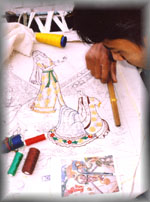 We
visit museums and crafts people, temples and tombs. There are highly-staged
cultural shows and quite impromptu performers. We dine at what we think are
the most interesting restaurants and have sufficient flexibility to enjoy
chance encounters. It's intelligent, exciting, stimulating: and fun!
We
visit museums and crafts people, temples and tombs. There are highly-staged
cultural shows and quite impromptu performers. We dine at what we think are
the most interesting restaurants and have sufficient flexibility to enjoy
chance encounters. It's intelligent, exciting, stimulating: and fun!
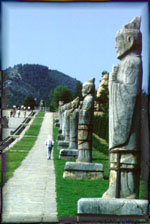 From
the 'Buried Warriors' of China's first emperor near Xian, and the tombs of
Imperial-royals and the buried treasures of the Tang we head by road to the
cave temples of Maji Shan with their graceful sculptures; then take a boat
up the Yellow River to the red cliffs and statues of Bingling Si.
From
the 'Buried Warriors' of China's first emperor near Xian, and the tombs of
Imperial-royals and the buried treasures of the Tang we head by road to the
cave temples of Maji Shan with their graceful sculptures; then take a boat
up the Yellow River to the red cliffs and statues of Bingling Si. 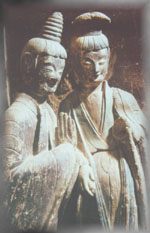
We take a train along the Gansu corridor, squeezed between
the Gobi desert to the north and the icy ramparts of the Tibetan plateau to
the south, to the southern edge of the Gobi desert and the painted caves of
Dunhuang.
Flying the 'northern route', we edge another, and more ominous desert, the Taklamakan which in Uigher
means 'if you go in, you won't come out!' We are heading for the modern capital
of Xinjiang, Urumchi, which has a museum crammed with wonders rescued from
the desert sands. Then on by road to nearby Turpan, whose summer sands would
grill an unprotected foot. This super-dry climate has protected the ancient
cities of Jaiohe and Gaochang as well as the painted caves of Bezeklik. We
track on through the great gorge of the Toksun where the road is squeezed
alternately by cliffs and by sand dunes to Korla. Here, a small museum contains
stunning treasures. From Korla we drive via the famous ancient city of Kuqa
into the Tien Shan (Heavenly) mountains. We are here to visit a very different
China: clear rivers, tree draped hills and ice-capped mountains!
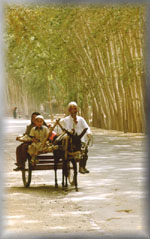 After
visiting the ancient Buddhist cave site of Kizil we drive directly across
the desert: four hundred and fifty kilometres of unrelenting sand is sufficient
evidence of difficult travel in these regions until very recent times. We
join the 'southern route' of the Silk Road near the ancient site of Niya.
It was the site made famous by Aurel Stein in the early 1900's and by more
recent explorers. The city of Khotan was always the source of China's finest
jade and the first city-state outside the Empire to steal the secrets of silk-culture.
Today, the production of colourful hand-loomed silk is thriving, and fossicking
in the Khotan river often reveals scraps of jade. In the oases of this southern
region life for the local Uigher people has changed little. Donkey carts are
the main form of transport, the men sport jaunty Astrakhan hats and the women,
colourful skirts and scarves. Its very pictureseque.
After
visiting the ancient Buddhist cave site of Kizil we drive directly across
the desert: four hundred and fifty kilometres of unrelenting sand is sufficient
evidence of difficult travel in these regions until very recent times. We
join the 'southern route' of the Silk Road near the ancient site of Niya.
It was the site made famous by Aurel Stein in the early 1900's and by more
recent explorers. The city of Khotan was always the source of China's finest
jade and the first city-state outside the Empire to steal the secrets of silk-culture.
Today, the production of colourful hand-loomed silk is thriving, and fossicking
in the Khotan river often reveals scraps of jade. In the oases of this southern
region life for the local Uigher people has changed little. Donkey carts are
the main form of transport, the men sport jaunty Astrakhan hats and the women,
colourful skirts and scarves. Its very pictureseque.
 At
Kashgar's justly-famed market, goods from all the countries of Central Asia
are on show. You can bargain yourself a fine carpet, select an embroidered
jacket from amongst myriads or design-yourself a selection of gold jewellery!
South from Kashgar, we drive high into the Pamirs to visit the fabled lake
of Kara Kul, rimmed by glaciers. Around its shores graze herds of placid double-humped
Bactrian camels - deliciously photogenic!
At
Kashgar's justly-famed market, goods from all the countries of Central Asia
are on show. You can bargain yourself a fine carpet, select an embroidered
jacket from amongst myriads or design-yourself a selection of gold jewellery!
South from Kashgar, we drive high into the Pamirs to visit the fabled lake
of Kara Kul, rimmed by glaciers. Around its shores graze herds of placid double-humped
Bactrian camels - deliciously photogenic!
Crossing into Kyrgyzstan via the Torugart Pass
we enter a scenic, highland grassy plateau. Snow capped peaks rim a land empty
of all but occasional herds of horses and sheep with their attendant human
guards. For one night we experience nomad life by staying in yurts near the
six hundred year old monument, Tash Rabat. The high lake of Song Kul has groups
of nomadic Kyrgyz living for summer months in felted yurts. At Kochkorka we
have a taste of family life in comfortable home-stays and will see their use
of shyrdak, the Kyrgyz traditional decorated felt. Bishkek, the capital,
is a lovely city of parks, pastel wooden houses and grand buildings of Imperial
Russian times. After almost a month in China, the restaurants are refreshingly
European, with wine readily available and cheap!
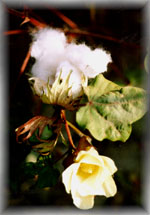 Tashkent
has some of the best museums of the tour and a pleasant relaxed atmosphere.
Our hotel is centrally located, allowing easy strolling to cafes, restaurants
or the magnificent opera house. Fergana has a gigantic cotton industry and
a thriving revival of handloomed ikat silk as well as distinctive pottery.
We fly to the old city of Khiva. Over centuries it became rich by trading
conventional silk-road-goods as well as slaves captured from Russia or Persia.
Not much trade these days, conventional or otherwise, but the bluish-green
tiled mosques and towers of those times remain to make it one of the most
picturesque in Central Asia.
Tashkent
has some of the best museums of the tour and a pleasant relaxed atmosphere.
Our hotel is centrally located, allowing easy strolling to cafes, restaurants
or the magnificent opera house. Fergana has a gigantic cotton industry and
a thriving revival of handloomed ikat silk as well as distinctive pottery.
We fly to the old city of Khiva. Over centuries it became rich by trading
conventional silk-road-goods as well as slaves captured from Russia or Persia.
Not much trade these days, conventional or otherwise, but the bluish-green
tiled mosques and towers of those times remain to make it one of the most
picturesque in Central Asia.
Isolated on all sides by the harsh Kara-kum desert,
Bukhara was always one of the great trading centres of the Silk Road. It was,
and is, the holiest city of the region. The blue domes of its mosques and madressas (religious schools) have towered above its brick-lined streets
for six hundred years. In recent times the crafts of metal-work, puppets,
painting and gold-thread embroidery have flourished. Formerly it was the major
centre for ikat production and the exquisite hand-embroided cloth known
as suzani; no longer produced, many examples are available in the numerous
bazaars.
 At
Shakrisabz and Samarkand, Timur-i-leng (Tamerlane) allowed his considerable
ego full reign creating what are arguably the greatest buildings in all Central
Asia. They are certainly the biggest and most grand! In Samarkand, the ruins
of Afrosiab with its fine frescoes speak of more forgiving and luxuriant non-Islamic
times ; and the remains of Ulug Bek's observatory of a period when Islamic
science was both accepted and inspired. The city also boasts the best hand-knotted
silk carpet factory in the world!
At
Shakrisabz and Samarkand, Timur-i-leng (Tamerlane) allowed his considerable
ego full reign creating what are arguably the greatest buildings in all Central
Asia. They are certainly the biggest and most grand! In Samarkand, the ruins
of Afrosiab with its fine frescoes speak of more forgiving and luxuriant non-Islamic
times ; and the remains of Ulug Bek's observatory of a period when Islamic
science was both accepted and inspired. The city also boasts the best hand-knotted
silk carpet factory in the world!
| In summary:
Threads in the Sand 2013 |
|
| a 51 day tour
ex New Zealand |
all
fares Auckland |
| 3 nights Bangkok |
|
| 25 nights in China |
including 4 in Kashgar |
| 6 nights in
Kyrgyzstan |
including
3 in Bishkek |
13 nights in Uzbekistan including |
4 nights Tashkent
1 night Fergana
2 nights Khiva
3 nights Bukhara
3 nights Samarkand |
It sounds fantastic. And so it is. But.......this epic tour involves more
than seven weeks of rigorous travel from China to Central Asia. Twice, we researched
this trip on the ground from one end to the other before conducting seven other
groups. After each trip we have slightly revised our timetable. We beleive
that what we offer provides the best possible experience. However, there are
hardships related to this region's socialist heritage and their relatively
recent introduction to tourism. For the most part, the
countries traversed are without a recent culture of service, and with a cavalier
approach to the environment. We will do our best to minimise these negatives
but please be conscious that travel in these regions requires a high level
of tolerance to difficulties both human and environmental.


a
Brief History
 istorically,
of course, it was never a single road, but a network of routes fanning out
from China to India, Central Asia, Russia, Byzantium and the West. In addition
to silk, the route carried many other precious commodities. Caravans heading
towards China carried gold and other precious metals, ivory, precious stones,
cotton, exotic animals, spices and glass. In the opposite direction furs,
ceramics, jade, bronze objects, lacquer and iron were carried. Many of these
goods were bartered for others along the way, and objects often changed hands
several times. When the world beyond the Middle Kingdom
discovered the lush beauty of Chinese silk they emptied their treasuries to
acquire this new and sensuous fabric. Thus was established the most famous
of all trade routes; a branching skein of links from China to Europe.
istorically,
of course, it was never a single road, but a network of routes fanning out
from China to India, Central Asia, Russia, Byzantium and the West. In addition
to silk, the route carried many other precious commodities. Caravans heading
towards China carried gold and other precious metals, ivory, precious stones,
cotton, exotic animals, spices and glass. In the opposite direction furs,
ceramics, jade, bronze objects, lacquer and iron were carried. Many of these
goods were bartered for others along the way, and objects often changed hands
several times. When the world beyond the Middle Kingdom
discovered the lush beauty of Chinese silk they emptied their treasuries to
acquire this new and sensuous fabric. Thus was established the most famous
of all trade routes; a branching skein of links from China to Europe.
Offically, it began in 138 BCE: by this time
the Han dynasty had stabilised northern China around the fertile plains of
the Yellow river. In fact, trade from China into Persia and the Central Asian
region had been established centuries before. The great Han emperor WuDi disturbed
by constant harassment from northern 'barbarians' and to protect existing
trade routes, sent envoys westward. They were in search of horses and allies
to defend themselves against these mounted marauders. These ambassadors returned
with news of empires further to the west. Persia, Parthia, India and Rome.
Trade in goods flourished and with it came great wealth. For more than a thousand
years the Han capital Chang-an (eternal peace) was to be the glory of a variably-unified
China. Modern-day Xian stands on the site of old Chang-an. It is here that
we start our travels through the history and cultures of the Silk Road.
As people moved back and forth along the route
they brought not only goods but ideas. The Tang dynasties welcomed other cultures
and other people. New styles of fashion, of dance and of music entertained
the glitterati of the Chinese court and Chinese methods of weaving, of agriculture
and technology were adopted in the west. Around the 8th century, the capital
of the Tang was the biggest, wealthiest, and most advanced city the world.
While London was a market town of a few thousand people, Ch'ang-an and its
suburbs was home to some two million people.
It was religious philosophy, however which had
the most lasting impact. From India, the gentle faith of Buddhism spread gradually
to merge with Daoist beliefs of harmony with nature. Well established by the
3rd century, Buddhism's message of personal responsibility and relief from
suffering were enthusiastically adopted both by community and the court. Monasteries
and pagodas constructed to celebrate the new faith, were lavishly decorated
with sculptures, paintings and the greatest treasures of the craftsman. The
Indian tradition of painted cave temples, was extensively developed especially
around the great deserts of the Gobi and Taklamakan. In celebration of the
Buddha, they crafted some of the most sublime religous art the world has seen
which is still preserved in museums and sites such as Maji Shan, Dunhuang
and Bingling Si.
Nestorian Christianity, Zoroastrianism, Judaism
and Manichaeism all made a less obvious impression on the Middle Kingdom.
It was Islam, sweeping from the Middle East in the 7th century that had a
chilling impact on the more forgiving cultures of China's western kingdoms.
At the battle of Talas in 751 Chinese armies were defeated by advancing Muslim
Turks. The Chinese lost political control of the Tarim basin and Islam replaced
Buddhism as the dominant belief system throughout the countries of Central
Asia. Islamic abhorrance of representations of the human form led to wholesale
defacement of statues and paintings. Fortunately many Buddhist sites were
preserved by the shifting sands of the desert to be uncovered by explorers
in the last century. In turn, the Muslims built stunning mosques and giant
towers, whose blue tiles match that of the heavens above. The great cities
of Khiva, Samarkand and Bukhara are their legacy.
The secrets of silk production escaped from
China around 500CE but Chinese dominance in production of the finest silk
textiles was to last for several centuries. Hazards of the overland route
began gradually to reduce both profit and pilgrimage. By the 8th century development
of sea routes from China to the Middle East were well established and successive
periods of instability along the Silk Route in Central Asia and Persia hastened
the decline of trade. With the advent of an inward-looking Qing dynasty in
the 16th century China withdrew from the world and and the once-great cities
and monuments of the Silk road were covered by desert sands. Throughout Central
Asia successive Khans established local rule but the attention of world powers
was elsewhere.
During the latter 19th century the great empires
of Russian and British India jockeyed for influence in the region. At that
time the region and its history was a blank. The 'Great Game' allowed explorers
like Hedin, and scholars like Stein and Le Coq to uncover the secrets. And
what great secrets they were! The Greek influence on Buddhist art; the buried
cities of the Taklamakan; and all their former glories, were completely unknown
in the west. More recent scholars have revealed the European ancestry of the
remarkably preserved mummies of the Taklamakan and their astonishing weaving
skills.
In the 1980's huge petroleum resources were found
beneath the sands of China's western desert and the steppes of Central Asia.
Once again the Silk Road has become a road of riches. A more liberal travel
regime in China and the opening of the republics of Central Asia to tourism
has made these ancient and modern wonders accessible to the modern explorer.
We pay special heed on our Footprints tour to
the history of this great commercial road. Its a history of remarkable tales
and extraordinary characters that make a very common bond across the shadows
of the centuries.


TEXTILES
and CRAFTS and CONCERTS
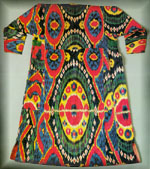 Ikat Silk: Delight, was my emotion on first seeing the ikat silks
of Bukhara. That delight has not diminished. The finest of these gorgeous
textiles are one hundred years old. We shall visit museums to see them en
masse as well as workshops where the tradition of hand looming has revived.
You will be able to see for yourselves the intricate techiques involved in
their production and buy samples to take home.
Ikat Silk: Delight, was my emotion on first seeing the ikat silks
of Bukhara. That delight has not diminished. The finest of these gorgeous
textiles are one hundred years old. We shall visit museums to see them en
masse as well as workshops where the tradition of hand looming has revived.
You will be able to see for yourselves the intricate techiques involved in
their production and buy samples to take home.
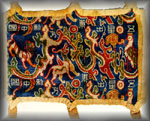 Ancient
textiles: The brocade silks from the sand-tombs
of the Taklamakan are more than fifteen hundred years old. These ancient relics
are astonishing! Well preserved because of the extreme aridity of their original
resting place, they spring into our times with vivid colours and complex weaving
designs. As we skirt around the vast desert of the Taklamakan we shall visit
museums where examples are on display. These have been taken from sites discovered
by Stein and others. Astana, Niya, Loulan, Endere, Sampula and Dandan Oilik
are a litany from the past. Buried cities from which have been rescued the
most amazing treasures. Not only textiles, but well preserved mummies, statues,
paintings and writings in forgotten tongues. None who visit can come away
unimpressed at the richness of these peoples lives!
Ancient
textiles: The brocade silks from the sand-tombs
of the Taklamakan are more than fifteen hundred years old. These ancient relics
are astonishing! Well preserved because of the extreme aridity of their original
resting place, they spring into our times with vivid colours and complex weaving
designs. As we skirt around the vast desert of the Taklamakan we shall visit
museums where examples are on display. These have been taken from sites discovered
by Stein and others. Astana, Niya, Loulan, Endere, Sampula and Dandan Oilik
are a litany from the past. Buried cities from which have been rescued the
most amazing treasures. Not only textiles, but well preserved mummies, statues,
paintings and writings in forgotten tongues. None who visit can come away
unimpressed at the richness of these peoples lives!
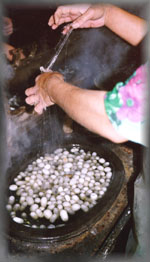 Silk
Culture: Sericulture or silk production has a long and colorful history
unknown to many. For more than two thousand years the Chinese kept the secret
of silk altogether to themselves. To protect their commercial advantage, it
was the most zealously guarded secret in history. At the borders of China
all travellers were searched. If found to be carrying silk worm eggs or the
seeds of the mulberry they were beheaded on the spot. For centuries the West
knew very little about silk and the people who made it. Pliny,
the Roman historian, wrote in his Natural History in 70 BCE "Silk was obtained by removing the down from the leaves with the help
of water…". In Khotan and Fergana we shall discover its
real origins and see in detail the delicate and lengthy processes involved
in the production of this entrancing fabric.
Silk
Culture: Sericulture or silk production has a long and colorful history
unknown to many. For more than two thousand years the Chinese kept the secret
of silk altogether to themselves. To protect their commercial advantage, it
was the most zealously guarded secret in history. At the borders of China
all travellers were searched. If found to be carrying silk worm eggs or the
seeds of the mulberry they were beheaded on the spot. For centuries the West
knew very little about silk and the people who made it. Pliny,
the Roman historian, wrote in his Natural History in 70 BCE "Silk was obtained by removing the down from the leaves with the help
of water…". In Khotan and Fergana we shall discover its
real origins and see in detail the delicate and lengthy processes involved
in the production of this entrancing fabric.
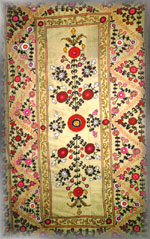 Silk
embrodieries (suzanis): One of the most beautiful products of Turkestan
culture are the large silk embroideries known as suzanis. These formed
an important part of a bride's dowry and were intended as decorations for
the interior of houses. Their area of distribution corresponds to modern Uzbekistan
and northern Tajikistan. Until modern times, young girls would commence sewing
their dowries as soon as they were able. Assisted by her mother and female
relatives a relatively well to do young woman would produce about ten large suzani in time for her wedding. The bold designs and subtle colours
of natural dyes make suzani attractive decorations. Numerous old ones
are available for purchase in the bazaars of Bukhara and Samarkand and we
shall see many fine examples in museums.
Silk
embrodieries (suzanis): One of the most beautiful products of Turkestan
culture are the large silk embroideries known as suzanis. These formed
an important part of a bride's dowry and were intended as decorations for
the interior of houses. Their area of distribution corresponds to modern Uzbekistan
and northern Tajikistan. Until modern times, young girls would commence sewing
their dowries as soon as they were able. Assisted by her mother and female
relatives a relatively well to do young woman would produce about ten large suzani in time for her wedding. The bold designs and subtle colours
of natural dyes make suzani attractive decorations. Numerous old ones
are available for purchase in the bazaars of Bukhara and Samarkand and we
shall see many fine examples in museums.
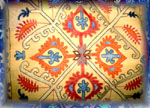 Felted
wool (shyrdak):Turkoman nomads who live
in the highlands use wool in many decorative ways. Their gurs (yurts)
are covered with felted wool blankets to keep them warm and to exclude rain
and snow. On the inside this same felting techique is adapted to make colourful
bags, hangings and winding-bands suitable for a nomadic life. In the high
grasslands of Kyrgyzstan we shall visit nomad camps as well as craftswomen
who have make attractive shyrdak for the tourist market.
Felted
wool (shyrdak):Turkoman nomads who live
in the highlands use wool in many decorative ways. Their gurs (yurts)
are covered with felted wool blankets to keep them warm and to exclude rain
and snow. On the inside this same felting techique is adapted to make colourful
bags, hangings and winding-bands suitable for a nomadic life. In the high
grasslands of Kyrgyzstan we shall visit nomad camps as well as craftswomen
who have make attractive shyrdak for the tourist market.
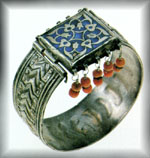 Jewellery: Turkoman tribal groups produce some of the most attractive jewellery we
shall see. Beaded necklets, silver and silk hair tassles, amulets of silver
and turquoise and chunky silver bracelets studded with carnelian are all available.
If that's not your style a 'bridal diadem' of gold, turquoise, pearl and amythest
should be just the thing for your next formal outing! If your taste runs more
to gold, there should be something to suit in one of the 300 shops along 'goldsmith
lane' in Kashgar.
Jewellery: Turkoman tribal groups produce some of the most attractive jewellery we
shall see. Beaded necklets, silver and silk hair tassles, amulets of silver
and turquoise and chunky silver bracelets studded with carnelian are all available.
If that's not your style a 'bridal diadem' of gold, turquoise, pearl and amythest
should be just the thing for your next formal outing! If your taste runs more
to gold, there should be something to suit in one of the 300 shops along 'goldsmith
lane' in Kashgar.
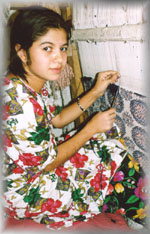 Carpets: Hand knotted woolen carpets have long been a feature of the region. Some
are produced in Khotan but the highest quality and most variety come from
peripheral countries that we do not visit. We shall not see their manufacture,
but thousand of new and antique wool carpets are available in the Kashgar
market.
Carpets: Hand knotted woolen carpets have long been a feature of the region. Some
are produced in Khotan but the highest quality and most variety come from
peripheral countries that we do not visit. We shall not see their manufacture,
but thousand of new and antique wool carpets are available in the Kashgar
market.
Superb hand knotted silk and wool carpets are made by the Badghissi family
factory in Samarkand. Refugees from Afghanistan, they provide a wonderfully
entertaining tour of their enterprise.
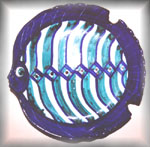 Pottery: At Riston, in the Fergana valley of Uzbekistan,
there is a long tradition of hand-crafted pottery. Some modern designers have
adapted their style to produce highly attractive wares. On each visit to the
pottery of Rustam Usimov almost everyone has bought - and, they have got their
purchase home safely!
Pottery: At Riston, in the Fergana valley of Uzbekistan,
there is a long tradition of hand-crafted pottery. Some modern designers have
adapted their style to produce highly attractive wares. On each visit to the
pottery of Rustam Usimov almost everyone has bought - and, they have got their
purchase home safely!
 Metalwork
and knives: Finely engraved or enamelled metalware
is a feature of Kashgar, Bukhara and Samarkand. And if you fancy an elaborate
knife to hang on your belt, Kashgar's the place.
Metalwork
and knives: Finely engraved or enamelled metalware
is a feature of Kashgar, Bukhara and Samarkand. And if you fancy an elaborate
knife to hang on your belt, Kashgar's the place.
Painting: In all
the tourist shops throughout China we shall see 'peasant
art'. This is a colourful primitive style depicting scenes of rural life.
Many paintings are repetitious, without flair: but every now and then there
is a picture full of life, originality and vitality. It pays to look! The
style in Central Asia is more delicate, with finely drawn ink sketches and
delicate portraits and watercolours. The best examples are in Bukhara and
Samarkand.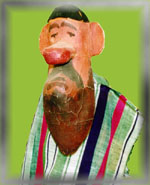
Puppets: Puppet
performances are a traditional Tadjik entertainment. There is an especially
inspired puppet maker selling his 'children' in the lanes of Khiva. They make
ideal gifts.
 Concerts: We attend a dinner-dance show in Xian that is our
introduction to the stage world of China. Drummers, diaphonous dancers, tumblers
and musicians... it's a great show!
Concerts: We attend a dinner-dance show in Xian that is our
introduction to the stage world of China. Drummers, diaphonous dancers, tumblers
and musicians... it's a great show!
Further west, the Muslim Turkoman peoples have a great love of music and dance.
We shall attend several concerts. Plenty of time to develop your tambourine
style!
A great gift from Imperial Russia to their southern colonies was a taste for
classical music, opera and ballet. The Czarists built elegant opera houses in Bishkek, Tashkent and Samarkand which were maintained by the Soviets and
to this day. Nowadays there are quality orchestras and ballet troupes, the
likes of which would grace any international concert hall. We shall be there!
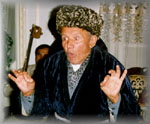 Spontaneous
musical performances can be great fun. Chance encounters, mostly in restaurants,
have enabled us to enjoy singers from Sichuan, a violinist from Azerbaijan
and musicians from Khorazhem. It just happens.. great!
Spontaneous
musical performances can be great fun. Chance encounters, mostly in restaurants,
have enabled us to enjoy singers from Sichuan, a violinist from Azerbaijan
and musicians from Khorazhem. It just happens.. great!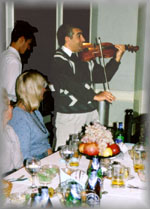


DESERT
and MOUNTAIN and GRASSLAND
 This
tour skirts the great Gobi, crosses the formidable Taklamakan and runs a goodly
length of the Kara Kum. Each different and in their own way extraordinarly
appealing: the curve of a dune, the scatterings of
blowing sand and the intense colours of their native rocks. At their heart,
the silence and the absence of life are unsettling and at the same time paradoxically
restful.
This
tour skirts the great Gobi, crosses the formidable Taklamakan and runs a goodly
length of the Kara Kum. Each different and in their own way extraordinarly
appealing: the curve of a dune, the scatterings of
blowing sand and the intense colours of their native rocks. At their heart,
the silence and the absence of life are unsettling and at the same time paradoxically
restful.
'As time went on the charm
of wide plains, the sweep of distant horizons, the austerity of silence and
solitude, increasingly attracted me. Long uneventful stages were not now something
to be endured as a necessary means of reaching a goal beyond the tedious waste,
but were desirable in themselves, and I ceased to crave for rapid transit
which would obliterate the spaces by mechanical means, for these very spaces
now meant so much to me that I valued them intensely for their own sake.'
The Gobi Desert: Cable, M & French, F.: Hodder & Stoughton 1942
The vast distance induces respect for those travellers who
walked these ways in pre-mechanical times. Even more perhaps for the Ms Cable
and French who travelled by bullock cart! Although we obliterate some space
by 'mechanical means' you can guarantee that if you didn't know an oasis from a karez before this trip you certainly will at the end!
'Those who imagine that
such a journey, its vast solitude and desolation is tedious and trying are
mistaken. No spectacle can be more sublime. Every day’s march, every
league brings discoveries of unimagined beauty.'
Sven Hedin 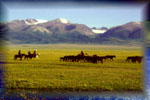
We make excursions into the Pamirs and the Tien
Shan. Amongst those same heavenly peaks we traverse the vast grasslands of
Bayinbulak and Kyrgzystan. From the harsh light and dusts of the desert, these
mountain glaciers, clear skies and greenery provide a welcome contrast.
Monuments to two great faiths, Buddhism and Islam, season
this tour. My personal favourite is Maji Shan. In caves cut into high
cliffs of 'haystack mountain' are scores of angular, inclined, and sublime,
statues of the Wei dynasty of sixteen hundred years ago.
 At Bingling Si the canvas is much more grand. Isolated in a remote side
valley of the Yellow river the caves are nestled into red sandstone cliffs
of organ-pipe grandeur. A massive Maitreya (the Buddha who is next to come)
looks out across a narrow canyon.
At Bingling Si the canvas is much more grand. Isolated in a remote side
valley of the Yellow river the caves are nestled into red sandstone cliffs
of organ-pipe grandeur. A massive Maitreya (the Buddha who is next to come)
looks out across a narrow canyon.
 The caves of Mao gao near Dunhuang stand at the eastern end of the
Taklamakan. It is the diamond-point of Chinese Buddhist art. Stretched along
two kilometres of cliffside are hundreds of caves, cut and painted by travellers
thankful to have survived the desert or more apprehensively, by those about
to enter. Continually extended for over a thousand years, their long history;
their state of preservation; and the thousands of contemporary documents discovered
within make this a site of international historical and artistic importance.
It is quite, quite magnificent.
The caves of Mao gao near Dunhuang stand at the eastern end of the
Taklamakan. It is the diamond-point of Chinese Buddhist art. Stretched along
two kilometres of cliffside are hundreds of caves, cut and painted by travellers
thankful to have survived the desert or more apprehensively, by those about
to enter. Continually extended for over a thousand years, their long history;
their state of preservation; and the thousands of contemporary documents discovered
within make this a site of international historical and artistic importance.
It is quite, quite magnificent.
'We were on our way to see
something that was very ancient, a place where men of one age make contact
with those of another. A thousand years and more lay between them and their
work and us and ours. It was fitting that a few hours of silence and solitude
should be imposed on us, for to pass, without transition, from any restless
or noisy life to this reliquary would be to offer it an insult.'
Mildred Cable on the desert approach to Dunhung
The Gobi Desert: Cable, M & French, F.: Hodder & Stoughton 1942
Representational art is anathema to conventional
Islam so further west there are no statues or paintings to delight the eye.
Instead, creative energy was directed to the construction of imposing buildings
with a covering of turquoise tiles.
According to Lord Curzon, the Madonna-blue domes surrounding the Registan
square in Samarkand made this place '..the
noblest public square in the world.'
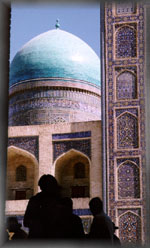 Just
nearby, is Shah-i-Zinda, a winding lane between six hundred year old blue-glazed
tombs. If has been justly described as a tour de fource of ceramic
art, where... 'Long faience panels are sculpted with
stylized flowers, calligraphy and pure, abstract designs borderd by bands
of mosaic and terracotta....with every shade of blue and every visual motif
.'
Just
nearby, is Shah-i-Zinda, a winding lane between six hundred year old blue-glazed
tombs. If has been justly described as a tour de fource of ceramic
art, where... 'Long faience panels are sculpted with
stylized flowers, calligraphy and pure, abstract designs borderd by bands
of mosaic and terracotta....with every shade of blue and every visual motif
.'

At Khiva, quite a different style
of colour and design prevails. A translucent blue-green tiling merges easily
into clear blue sky in the Islam Khodja minaret.
'The true importance of
our discovery was all in the mind, for we had reached one of those rare sacred
places where myth and reality meet, where the dream world and the true world
become one.'
Marcel Peissel, The Last Babarians, 1997


ITINERARIES
and PRICES: Threads in the Sand 2013
LAND ONLY
group: 2013
 hose who wish to travel elsewhere in Asia or travel on to
Europe may prefer this option.
hose who wish to travel elsewhere in Asia or travel on to
Europe may prefer this option.
Note: this option starts in Shanghai and ends in Bangkok.
Threads in the Sand 2013
| Land Only
| join in Shanghai 18 August - leave in Tashkent 03 October 2013 |
|
47 day trip |
|
24 days on tour in central & western China |
|
7 days on tour in Kyrgyzstan |
|
14 days on tour in Uzbekistan |
|
all breakfasts, most lunches and many dinners |
|
all admissions and permits |
|
land & air transportation to Tashkent |
|
US$ 10,768 was the final price for 2012 (Shanghai-Tashkent)
A final price for Threads 2013 will be decided early 2013 and will be sent to those interested. |
Please note: These prices when published are final
but I reserve the right to make changes should major movements occur in currency
or airfares.
N.B. If you choose the land-only option please organise your air travel
early. Flights to and from Asia are very heavily booked. I am happy to help
with suggestions and flight bookings if you wish.
'What
shall we tell you? Tales, marvellous tales, Of ships and stars and isles
where good men rest, Where nevermore the rose of sunset pales, And winds
and shadows fall toward the west.'
James Elroy Flecker: The Story of Hassan of Baghdad,
and how he took The Golden Journey to Samarkand: 1922


 Main
group: 2013
Main
group: 2013
Threads in the Sand 2013
| Main Group ex NZ
| 17 August - 06 October 2013 (Auckland - Auckland) |
|
51 day trip |
|
25 days on tour in central & western China |
|
7 days on tour in Kyrgyzstan |
|
14 days on tour in Uzbekistan |
|
3 nights in Bangkok |
|
all breakfasts, most lunches and many dinners |
|
all admissions and permits |
|
land & air transportation throughout |
|
The final price for the 2012 tour was US$10,768 (NB the 2012 tour)
The 2012 Airfare was: NZ$2,417 - airfare
only (Auckland-Auckland)
A final price for Threads 2013 will be decided early in 2013 and will be sent to those interested. It is very dependent on the NZ$ exchange rate to the US$. |
|
|
|
extra charge applies from other New Zealand cities. |
|
|
|
|
Please note: Prices, when published,
are final but I reserve the right to make changes should major movements occur
in currency or airfares.


What do you get?
An informative, highly personalised
introduction to some new places and interesting people with me! Return economy
airfare from Christchurch, Wellington or Auckland to Bangkok and Shanghai
· Twin-share accommodation in all cities · Breakfasts everyday · All Lunches
and many dinners · A celebratory group dinner in ...I'm not sure, but somewhere
nice!· Airport transfers and departure taxes throughout · all admission fees
to museums and monuments.
What you don't get:
Visa fees for the countries visited [you will be sent information
about this]. NZ departure tax · dinner, unless specified [most are provided]·
personal insurance and medical expenses · excess baggage charges and items
of a personal nature. 

 Is
it worth it?
Is
it worth it?
 his is a unique exploration of one famed silk route from
China to Central Asia. It has been researched on the ground from start to
finish, with the tour constructed to take the best advantage of the regions
history and attractions. There is a particular emphasis on textiles, on crafts
and the history of the region. It is delibrately not rushed.
his is a unique exploration of one famed silk route from
China to Central Asia. It has been researched on the ground from start to
finish, with the tour constructed to take the best advantage of the regions
history and attractions. There is a particular emphasis on textiles, on crafts
and the history of the region. It is delibrately not rushed.
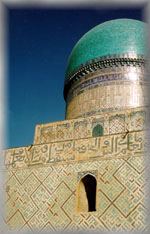 Please
compare this trip with others. I am sure we are not the cheapest, but we strive
to be the most personalised and the best: with the hope that we may all journey
through these lands like Freya Stark...
Please
compare this trip with others. I am sure we are not the cheapest, but we strive
to be the most personalised and the best: with the hope that we may all journey
through these lands like Freya Stark...
'A good traveller does not much mind
the uninteresting places. He is there inside them, as a thread is inside
the necklace it strings….. To find this unity makes me happy: its discovery
comes unexpectedly upon me, not only with people, but with animals, or trees
or rocks, or days and nights in their mere progress. A sudden childish delight
envelops me and the frontiers of myself disappear.'
Freya Stark: Alexander’s Path John Murray 1958
'.....if this one day
in the lifetime of a hundred years is lost,
will you ever get your hands on it again?'
Is this a good trip?
Why don't you find out?


 What
other information do you send?
What
other information do you send? 
fter registration I shall send pre-trek information including; a daily tour
itinerary; detailed information about what you need to prepare and bring for
this tour; a suggested reading list; information relating to health issues
and vaccinations.

